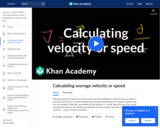
Example of calculating speed and velocity
- Subject:
- Physical Science
- Physics
- Material Type:
- Lesson
- Provider:
- Khan Academy
- Author:
- Sal Khan
- Date Added:
- 09/22/2013

Example of calculating speed and velocity

Calculating the dot and cross products when vectors are presented in their x, y, and z (or i,j, and k) components.
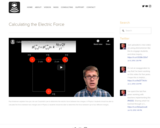
Paul Andersen explains how you can use Coulomb's Law to determine the electric force between two charges. In Physics 1 students should be able to calculate the force between two charges and in Physics 2 students should be able to determine the force between up to four different charges.

Paul Andersen explains why astronauts are weightless. He also explains how Newton's Universal Law of Gravitation can be used to calculate the gravitational force between objects.

Proving that a = v^2/r

Students apply their knowledge of linear regression and design to solve a real-world challenge to create a better packing solution for shipping cell phones. They use different materials, such as cardboard, fabric, plastic, and rubber bands to create new “composite material” packaging containers. Teams each create four prototypes made of the same materials and constructed in the same way, with the only difference being their weights, so each one is fabricated with a different amount of material. They test the three heavier prototype packages by dropping them from different heights to see how well they protect a piece of glass inside (similar in size to iPhone 6). Then students use linear regression to predict from what height they can drop the fourth/final prototype of known mass without the “phone” breaking. Success is not breaking the glass but not underestimating the height by too much either, which means using math to accurately predict the optimum drop height.

This lab demonstrates Ohm's law as students set up simple circuits each composed of a battery, lamp and resistor. Students calculate the current flowing through the circuits they create by solving linear equations. After solving for the current, I, for each set resistance value, students plot the three points on a Cartesian plane and note the line that is formed. They also see the direct correlation between the amount of current flowing through the lamp and its brightness.

This lesson introduces students to the concept of air pressure. Students will explore how air pressure creates force on an object. They will study the relationship between air pressure and the velocity of moving air.
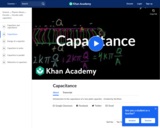
Introduction to the capacitance of a two plate capacitor
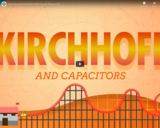
The video resource "Capacitors and Kirchhoff: Crash Course Physics #31" is included in the "Media Literacy" course from the resources series of "Crash Course". Crash Course is a educational video series from John and Hank Green.

Students are presented with a short lesson on the difference between cohesive forces (the forces that hold water molecules together and create surface tension) and adhesive forces (the forces that causes water to "stick" to solid surfaces. The interaction between cohesive forces and adhesive forces causes the well-known capillary action. Students are also introduced to examples of capillary action found in nature and in our day-to-day lives.
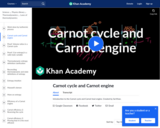
Introduction to the Carnot Cycle and Carnot Heat Engine
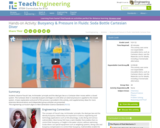
Students observe Pascal's law, Archimedes' principle and the ideal gas law as a Cartesian diver moves within a closed system. The Cartesian diver is neutrally buoyant and begins to sink when an external pressure is applied to the closed system. A basic explanation and proof of this process is provided in this activity, and supplementary ideas for more extensive demonstrations and independent group activities are presented.
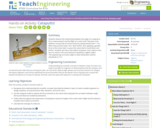
Students observe the relationship between the angle of a catapult (a force measurement) and the flight of a cotton ball. They learn how Newton's second law of motion works by seeing directly that F = ma. When they pull the metal "arm" back further, thus applying a greater force to the cotton ball, it causes the cotton ball to travel faster and farther. Students also learn that objects of greater mass require more force to result in the same distance traveled by a lighter object.

Introduction to the center of mass
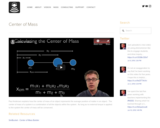
Paul Andersen explains how the center of mass of an object represents the average position of matter in an object. The center of mass of a system is a combination of all the objects within the system. As long as no external torque is applied to the system the center of mass will be conserved.

The direction of the force in cases of circular motion at constant speeds

This lesson begins with an activity in which students induce EMF in a coil of wire using magnetic fields. Then, demonstrations on Eddy currents show how a magnetic field can slow magnets just as Eddy currents are used to slow large trains. There is then a demonstration in which a loop "jumps" because of a changing magnetic field. Finally, formal lecture reviews the cross product with respect to magnetic force and introduces magnetic flux, Faraday's law of Induction, Lenz's Law, Eddy currents, motional EMF and Induced EMF.

Student groups are given captioned photographs of the Chernobyl Nuclear Power Plant facility and surrounding towns taken before and 28 years after the 1986 disaster. Based on the captions and clues in the images, they arrange them in sequential order. While viewing the completed sequence of images, students reflect on what it might have been like to be there, and ask themselves: what were people thinking, doing and saying at each point? This activity assists students in gaining an understanding of how devastating nuclear meltdowns can be, which underscores the importance of responsible engineering. It is recommended that this activity be conducted before the associated lesson, Nuclear Energy through a Virtual Field Trip.
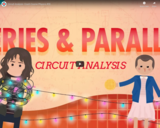
The video resource "Circuit Analysis: Crash Course Physics #30" is included in the "Media Literacy" course from the resources series of "Crash Course". Crash Course is a educational video series from John and Hank Green.